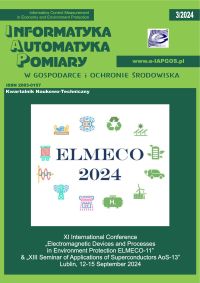ROZWIĄZYWANIE PROBLEMU USZKODZEŃ MARKERÓW TRASY W SYSTEMIE OPARTYM O WÓZKI SAMOJEZDNE – STUDIUM PRZYPADKU
Tomasz Lewowski
tomasz.lewowski@ratelware.comWrocław University of Science and Technology, Faculty of Computer Science and Management, Department of Applied Informatics, Wrocław, Poland; Octant sp. z o.o., www.octant.pl (Polska)
http://orcid.org/0000-0003-4897-1263
Abstrakt
Ten artykuł opisuje studium przypadku rozwoju podsystemu lokalizacji i pozycjonowania w systemie opartym na wózkach samojezdnych. Opisywany system używa markerów RFID w celu lokalizacji wózków. Markery te w niektórych wdrożeniach okazjonalnie ulegają uszkodzeniom – najczęściej mechanicznym, ze względu zgniecenia powstałe w wyniku przejechania przez platformę z ładunkiem kierowaną przez człowieka lub też wewnętrzne defekty. Uszkodzenia te występują na tyle rzadko, że nie uzasadniają zmiany sposobu lokalizacji na bardziej zaawansowany, jednakże wymagają dodatkowego wysiłku od kadry zajmującej się utrzymaniem ruchu. W tym studium przypadku opisane zostało rozwiązanie przyjęte w firmie Octant – samostrojący się algorytm wykrywający uszkodzenia markerów, w przypadku typowych uszkodzeń umożliwiający kontynuację pracy systemu. Publikacja ogólnie opisuje sytuację biznesową w której zastosowanie takiego rozwiązania jest racjonalne, a następnie opisuje szczegóły techniczne podsystemów odpowiedzialnych za ruch i pozycjonowanie pojazdu – zarówno fizycznych, jak i w zakresie oprogramowania – oraz uzasadnienia dla podjętych decyzji technicznych.
Słowa kluczowe:
Sterowanie przemysłowe, Pojazdy samojezdne, Odporność na uszkodzenia, Utrzymanie ruchuBibliografia
Bandyopadhyay S.: Intelligent Vehicles and Materials Transportation in the Manufacturing Sector: Emerging Research and Opportunities. IGI Global 2017.
DOI: https://doi.org/10.4018/978-1-5225-3064-0
Google Scholar
Campion G., Bastin G., D’Andréa-Novel B.: Structural properties and classification of kinematic and dynamic models of wheeled mobile robots. Proceedings IEEE International Conference on Robotics and Automation (IEEE) 1993, [http://doi.org/10.1109/ROBOT.1993.292023].
DOI: https://doi.org/10.1109/ROBOT.1993.292023
Google Scholar
Clausing D.: Taguchi methods to improve the development process. IEEE International Conference on Communications – Spanning the Universe 2, 1988 826–832, [http://doi.org/10.1109/ICC.1988.13674].
DOI: https://doi.org/10.1109/ICC.1988.13674
Google Scholar
Deming W. E.: Sample Design in Business Research. Wiley-Interscience, 1990.
Google Scholar
Dreyfus S.: An Appraisal of Some Shortest-Path Algorithms. Operations Research 17(3), 1969, [http://doi.org/10.1287/opre.17.3.395].
DOI: https://doi.org/10.1287/opre.17.3.395
Google Scholar
Ismail A. H., Ramli H. R., Ahmad M. H., Marhaban M. H.: Vision-based system for line following mobile robot. IEEE Symposium on Industrial Electronics & Applications 2009, 642–645, [http://doi.org/10.1109/ISIEA.2009.5356366].
DOI: https://doi.org/10.1109/ISIEA.2009.5356366
Google Scholar
Lee J-W., Choi S-U., Lee C-H., Lee Y-J., Lee K-S: A study for AGV steering control and identification using vision system. IEEE International Symposium on Industrial Electronics Proceedings 3, 2001, 1575–1578 (Cat. No. 01TH8570), [http://doi.org/10.1109/ISIE.2001.931941].
DOI: https://doi.org/10.1109/ISIE.2001.931941
Google Scholar
Leitner S. H., Mahnke W.: OPC UA–service-oriented architecture for industrial applications. ABB Corporate Research Center 48, 2006, 61–66.
Google Scholar
Li L., Schultze L.: Comparison and Evaluation of SLAM Algorithms for AGV Navigation. F.-J. Villmer, E. Padoano (Eds.): Department of Production Engineering and Management. Production Engineering and Management. Lemgo 2018.
Google Scholar
Pang Y., De La Cruz A. L., Lodewijks G.: Bipolar magnetic positioning system for automated guided vehicles. IEEE Intelligent Vehicles Symposium 2008, 883–888, [http://doi.org/10.1109/IVS.2008.4621228].
DOI: https://doi.org/10.1109/IVS.2008.4621228
Google Scholar
Park J., Kim J. Y., Kim B., Kim S.: Global Map Generation using LiDAR and Stereo Camera for Initial Positioning of Mobile Robot. International Conference on Information and Communication Technology Robotics (ICT-ROBOT), 2018, 1–4, [http://doi.org/10.1109/ICT-ROBOT.2018.8549897].
DOI: https://doi.org/10.1109/ICT-ROBOT.2018.8549897
Google Scholar
Park J., Lee J., Park Y., Kim S. W.: AGV parking system based on tracking landmark. 6th International Conference on Electrical Engineering/Electronics, Computer, Telecommunications and Information Technology 2009, 340–343 [http://doi.org/10.1109/ECTICON.2009.5137022].
DOI: https://doi.org/10.1109/ECTICON.2009.5137022
Google Scholar
Quan S., Chen J.: AGV Localization Based on Odometry and LiDAR. 2nd World Conference on Mechanical Engineering and Intelligent Manufacturing 2019, 483–486, [http://doi.org/10.1109/WCMEIM48965.2019.00102].
DOI: https://doi.org/10.1109/WCMEIM48965.2019.00102
Google Scholar
Ray K. A., Gupta M., Behera L., Jamshidi M.: Sonar based Autonomous Automatic Guided Vehicle (AGV) navigation. IEEE International Conference on Systems and System Engineering 2008, 1–6,[http://doi.org/10.1109/SYSOSE.2008.4724179].
DOI: https://doi.org/10.1109/SYSOSE.2008.4724179
Google Scholar
Wiklund U., Andersson U., Hyyppä K.: AGV navigation by angle measurements. Automated guided vehicle systems: Proceedings of the 6th International Conference 1988, 199–212.
Google Scholar
Wang D., Low C. B.: Modeling Skidding and Slipping in Wheeled Mobile Robots: Control Design Perspective. IEEE/RSJ International Conference on Intelligent Robots and Systems 2006, 1867–1872,[http://doi.org/10.1109/IROS.2006.282309].
DOI: https://doi.org/10.1109/IROS.2006.282309
Google Scholar
Autorzy
Tomasz Lewowskitomasz.lewowski@ratelware.com
Wrocław University of Science and Technology, Faculty of Computer Science and Management, Department of Applied Informatics, Wrocław, Poland; Octant sp. z o.o., www.octant.pl Polska
http://orcid.org/0000-0003-4897-1263
Statystyki
Abstract views: 302PDF downloads: 189
Licencja

Utwór dostępny jest na licencji Creative Commons Uznanie autorstwa – Na tych samych warunkach 4.0 Miedzynarodowe.








